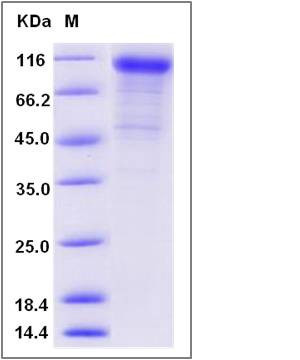Mouse Cadherin-6 / CDH6 Protein (His Tag)
cad6,cadherin-6,K-cadherin
- 100ug (NPP3257) Please inquiry
| Catalog Number | P50985-M08H |
|---|---|
| Organism Species | Mouse |
| Host | Human Cells |
| Synonyms | cad6,cadherin-6,K-cadherin |
| Molecular Weight | The recombinant mouse CDH6 comprises 616 amino acids and has a predicted molecular mass of 68.7 kDa. The apparent molecular mass of the protein is approximately 98 kDa in SDS-PAGE under reducing conditions due to glycosylation. |
| predicted N | Thr 19 |
| SDS-PAGE |  |
| Purity | > 90 % as determined by SDS-PAGE |
| Protein Construction | A DNA sequence encoding the mouse CDH6 (P97326) (Met1-Ala615) was expressed with a C-terminal polyhistidine tag. |
| Bio-activity | |
| Research Area | Developmental Biology |Embryogenesis |Axis Formation |Canonical Wnt Pathway |
| Formulation | Lyophilized from sterile PBS, pH 7.4 1. Normally 5 % - 8 % trehalose, mannitol and 0.01% Tween80 are added as protectants before lyophilization. Specific concentrations are included in the hardcopy of COA. |
| Background | Cadherins are a family of calcium-dependent, cell-cell adhesion molecules that play an important morphoregulatory role in a wide variety of tissues. Alterations in cadherin function have been implicated in tumor progression in a number of adenocarcinomas. Cadherin-6 (CDH6), also known as K-cadherin (KCAD), is a type-II classic cadherin cell-cell adhesion molecules, which are expressed in graded or areal patterns, as well as layer-specific patterns, in the cortical plate. Human Cadherin-6 is synthesized as a 790 aa type I transmembrane glycoprotein that contains a 18 aa signal peptide, a 35 aa propeptide, a 562 aa extracellular region, a 21 aa transmembrane segment, and a 154 aa cytoplasmic domain. There are five cadherin domains of approximately 110 aa each in the extracellular region. Cadherin-6 is highly expressed in brain, cerebellum, and kidney, and may contribute to the formation of the segmental structure of the early brain, as well as the development of renal proximal tubules. Weak expression is also detected lung, pancreas, and gastric mucosa. Additionally, it is specifically expressed in the proximal tubule of normal kidneys and in renal cell cancer. Thus , Cadherin-6 is a new prognostic factor for renal cancer. |
| Reference |
